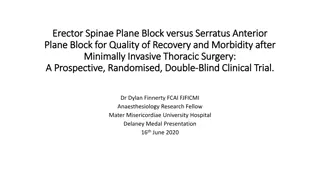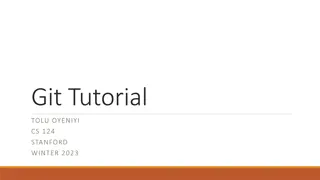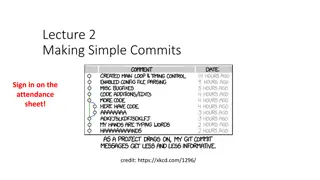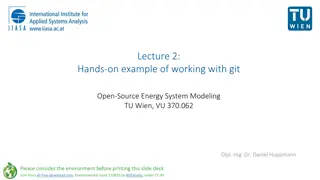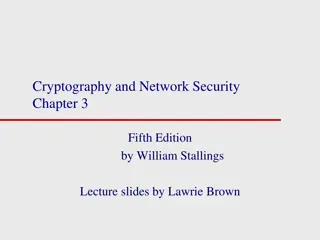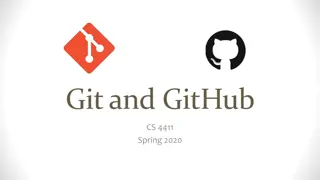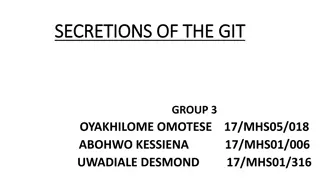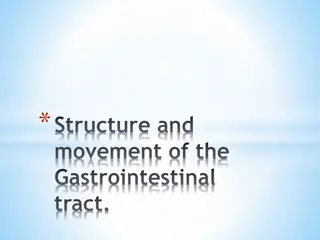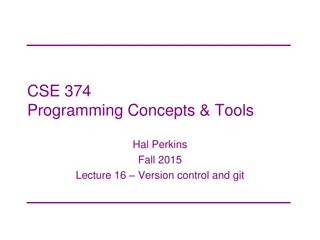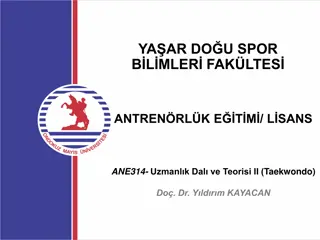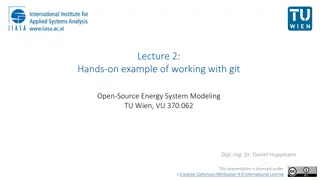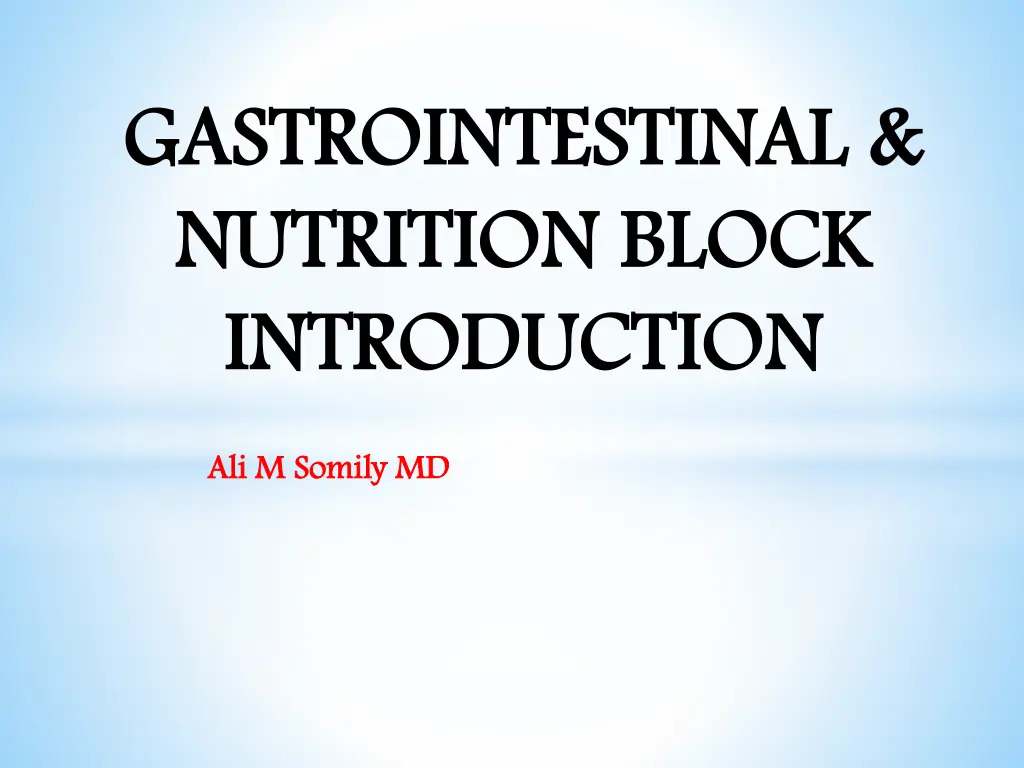
Gastrointestinal and Nutrition Block Overview
Explore the objectives, teaching models, and examination details of the Gastrointestinal and Nutrition Block. Topics include anatomical structures, functions, pathology, pharmacology, epidemiology, hematology, and more. Various teaching methods like small group lectures, practical sessions, and self-directed learning are utilized to enhance students' understanding. The block covers a range of GI and hematopoietic system topics, including esophagus, stomach, pancreas, small intestine, colon, liver, spleen, gallbladder, and biliary system. Examinations and lectures are structured to consolidate knowledge and assess students' comprehension.
Download Presentation

Please find below an Image/Link to download the presentation.
The content on the website is provided AS IS for your information and personal use only. It may not be sold, licensed, or shared on other websites without obtaining consent from the author. If you encounter any issues during the download, it is possible that the publisher has removed the file from their server.
You are allowed to download the files provided on this website for personal or commercial use, subject to the condition that they are used lawfully. All files are the property of their respective owners.
The content on the website is provided AS IS for your information and personal use only. It may not be sold, licensed, or shared on other websites without obtaining consent from the author.
E N D
Presentation Transcript
GASTROINTESTINAL & GASTROINTESTINAL & NUTRITION BLOCK NUTRITION BLOCK INTRODUCTION INTRODUCTION Ali M Somily MD Ali M Somily MD
OBJECTIVES OBJECTIVES By the end of the gastrointestinal and haematology block, students should be able to: Correlate Correlate between between the the anatomical anatomical structures functions functions. . Use Use the the basic basic sciences sciences to to interpret and and investigation investigation results results Understand Understand the the pathology, pathology, pathogenesis pathogenesis of of the the common common disorders Discuss Discuss the the pharmacological pharmacological basis Epidemiology Epidemiology and and preventive preventive approaches structures and and their their interpret symptoms, symptoms, signs signs microbiology microbiology disorders and and basis of of drugs drugs approaches
OBJECTIVES OBJECTIVES Revisit Revisit epidemiological epidemiological parameters Body Body mass mass index index Macro Macro and and micro micro nutritional population population. . Normal Normal haemopoiesis haemopoiesis and haemopoietic haemopoietic cells cells. . Disorders Disorders affecting affecting the particular particular emphasis emphasis on Role Role of of haemoglobin haemoglobin and metabolism metabolism. . Develop Develop communication communication and level level of of a a medical medical student parameters such such as as nutritional requirements requirements of of a a and the the functions functions of of different different the haemopoietic haemopoietic system, on anaemia anaemia. . system, with with and its its types types of of and and iron iron and professional professional skills student. . skills at at the the
TEACHING & LEARNUNG MODLES TEACHING & LEARNUNG MODLES Small Small group Lectures Lectures Student Student- -led Practical Practical classes Clinical Clinical skills Self Self- -directed directed learning Writing Writing an an essay E E- -learning learning sessions group discussion discussion led seminars seminars classes skills learning essay or or mini mini thesis thesis sessions
LECTURES & EXAMINATIONS Esophagus and Stomach. Esophagus and Stomach. Pancreas. Pancreas. Small Intestine. Small Intestine. Colon. Colon. Liver & Liver & hematopoietic hematopoietic system. Spleen & hematopoietic Spleen & hematopoietic system. Gallbladder & Gallbladder & Biliary System. Seven Seven Weeks Week 5: Week 5: Midblock Examination Midblock Examination 17 December 17 December 2017 Week Week 7: Consolidation from 02 7: Consolidation from 02 Jan Jan 2018 to 04 January 2018 to 04 January 2018 Week 8: Examination week from Week 8: Examination week from 07 January 2018 to 11 January 07 January 2018 to 11 January 2018 2018 Weeks 2017 2018 system. system. Biliary System. Total Total 88 lectures 88 lectures 9 practical's 9 practical's
Week (1) Starting: 19/11/2017 to 23/11/2017 Week (1) Starting: 19/11/2017 to 23/11/2017 OESOPHAGUS OESOPHAGUS AND STOMACH AND STOMACH Department Department Lectures Microbiology Microbiology Lectures (14) 1. H pylori and drugs used in treatment (14) Practical Practical Anatomy Anatomy 1. Anatomy of the oral cavity oseophagus and stomach Histology of the esophagus and stomach Anatomy and histology of the salivary glands General principles of GIT physiology Oesophageal motility and pathophysiology of reflux disease Physiology of the stomach and regulation of gastric secretions Role of salivary gland and stomach in digestion Structure and function of haemoglobin Gastro Esophageal Reflux Disease (GERD) Pathology and pathophysiology of peptic ulcer Anemia Anatomy, histology and radiology of the eosophagus & stomach 2. 3. 1. 2. Physiology Physiology 3. Biochemistry Biochemistry 1. 2. 1. 2. 1. Pathology Pathology Haematology Haematology Radiology Radiology Pharmacology Pharmacology 1. 2. H2 blockers and proton pump inhibitors Antiemetic drugs Family & Family & Community Community Medicine Medicine
Week (2) Starting : 26/11/2017 to 30/11/2017 Week (2) Starting : 26/11/2017 to 30/11/2017 PANCREAS PANCREAS Department Department Microbiology Microbiology Lectures Lectures (12) (12) Practical Practical Anatomy Anatomy 1. Anatomy and histology of pancreas and biliary system Embryology of the pancreas and small intestine Introduction to Pleuripotent stem cell Physiology of pancreas Biochemical aspects of digestion of lipids Biochemical aspects of digestion of proteins and carbohydrates Nutritional requirements Plasma proteins Macro and micro nutrients Pathology and pathogenesis of acute and chronic pancreatitis Hemoglobinopathies Transfusion & Cross-matching 2. 3. 1. 1. 2. Physiology Physiology Biochemistry Biochemistry 3. 4. 5. 1. Pathology Pathology GERD & Peptic Ulcer Haematology Haematology 1. 2. Radiology Radiology Pharmacology Pharmacology
Week (3) Starting : 03/12/2017 to 07/12/2017 Week (3) Starting : 03/12/2017 to 07/12/2017 SMALL INTESTINE SMALL INTESTINE Department Department Microbiology Microbiology Lectures Lectures (12) 1. Normal flora and introduction to infectious diarrhea 2. Cholera 3. Intestinal helminthes 4. Viral gastroenteritis 5. Intestinal protozoa 6. Shigella and salmonella 1. Anatomy and histology of the small intestine 1. Physiology of the small intestine: motility and secretion (12) Practical Practical Anatomy Anatomy Physiology Physiology Biochemistry Biochemistry Clinical chemistry and pathology practical about malabsorption, acute and chronic pancreatitis Pathology Pathology 1. Pathology and the mechanisms of malabsorption Pathophysiology and mechanisms of diarrhea 2. Haematology Haematology Radiology Radiology Pharmacology Pharmacology Family & Community Medicine Family & Community Medicine 1. Radiology of the abdomen 1. Nutrition Education
Week (4) Starting: 10/12/2017 to 14/12/2017 Week (4) Starting: 10/12/2017 to 14/12/2017 COLON COLON Department Department Microbiology Microbiology Anatomy Anatomy Lectures (12) Lectures (12) 1. Schistosomiasis 1. Anatomy and histology of the large intestine 2. Anatomy of the omentum Practical Practical Anatomy, histology and radiology of the small and large intestine Physiology Physiology Biochemistry Biochemistry Pathology Pathology 1. Physiology of the colon: motility 1. 2. 3. Colonic tumours and polyps-I Colonic tumors and polyps-II Inflammatory bowel disease and Crohn s disease Inflammatory bowel disease and ulcerative colitis 4. Haematology Haematology Radiology Radiology Pharmacology Pharmacology 1. 2. 3. Treatment of dysentery and amoebiasis Drugs used in treating constipation and IBS Drugs used in IBD and biological and immune therapy of IBD Irritable bowel syndrome Family & Community Family & Community Medicine Medicine 1.
*Week (5) Starting: 17/12/2017 to 21/12/2017 LIVER & hematopoietic system Department Department Lectures (18) Microbiology Microbiology Lectures (18) 1. Trypanosomiasis 2. Leishmaniasis 3. Viral hepatitis B, C, D and G 1. Anatomy of the liver and spleen 1. Bilirubin metabolism 2. Platelets structure and functions 3. Reticuloendothelial system and function of the spleen 4. Coagulation mechanisms Practical Practical Anatomy Anatomy Physiology Physiology Biochemistry Biochemistry 1. 2. 3. 4. 1. 2. 3. Liver function tests Biochemical aspects of bile acids and salts Urea cycle Biochemistry of vitamin K Pathology and pathogenesis of liver Cirrhosis Complication of liver cirrhosis Cancer of the liver and pancreas Pathology Pathology Haematology Haematology Radiology Radiology Pharmacology Pharmacology 1. Approach to bleeding disorders 1. 2. Cytochrome system and drug metabolism Hepatotoxic drugs Family & Community Family & Community Medicine Medicine
Week (6) Starting: 24/12/2017 to 28/12/2017 Spleen & hematopoietic system Department Department Lectures (15) Lectures (15) Microbiology Microbiology 1. Malaria 2. Viral hepatitis A and E Anatomy Anatomy 1. Histology of the liver and spleen Physiology Physiology Biochemistry Biochemistry 1. G6PD Pathology Pathology Practical Practical Liver function test(Integrated Biochemistry & Pathology) Hemoglobinopathies Haematology Haematology 1. Acute leukemia I 2. Acute leukemia II 3. Megaloblastic anaemia 4. Chronic Leukemia 5. Polycythemia 6. Lymphoproliferative disorder 7. Approach to Hemolysis Radiology Radiology Pharmacology Pharmacology 1. Anti-coagulant drugs 2. Anti-Malarial Drugs 3. Anti-Platelet Drugs 1. Pathophysiology of ascitis Family & Community Medicine Family & Community Medicine
*Week (7) Starting: 31/12/2017 to 04/01/2018 Gallbladder & BILIARY SYSTEM Department Department Lectures (5) Lectures (5) Microbiology Microbiology Practical Practical 1. Blood Parasites 2. Hepatitis Anatomy Anatomy Physiology Physiology 1. Physiology of bile salts and enterohepatic Circulation Biochemistry Biochemistry Pathology Pathology 1. Pathology and pathogenesis of gallstones and cholecystitis 1-Liver, biliary system and pancreas Haematology Haematology Radiology Radiology 1. Bleeding disorders 1. Ultrasound of the liver and gallstones Anatomy, histology and radiology of liver, spleen, pancreas and biliary system Pharmacology Pharmacology Family & Community Family & Community Medicine Medicine
EVALUATION EVALUATION SI. SI. No No Item Item Marks Marks 1 Small Group 5 2 Midterm MCQs 20 3 Short Answer Question (SAQs) 20 4 Final MCQs 30 5 OSPE 20 6 Clinical Skills 5 TOTAL 100
THANK YOU WISH YOU THE BEST OF LUCK




